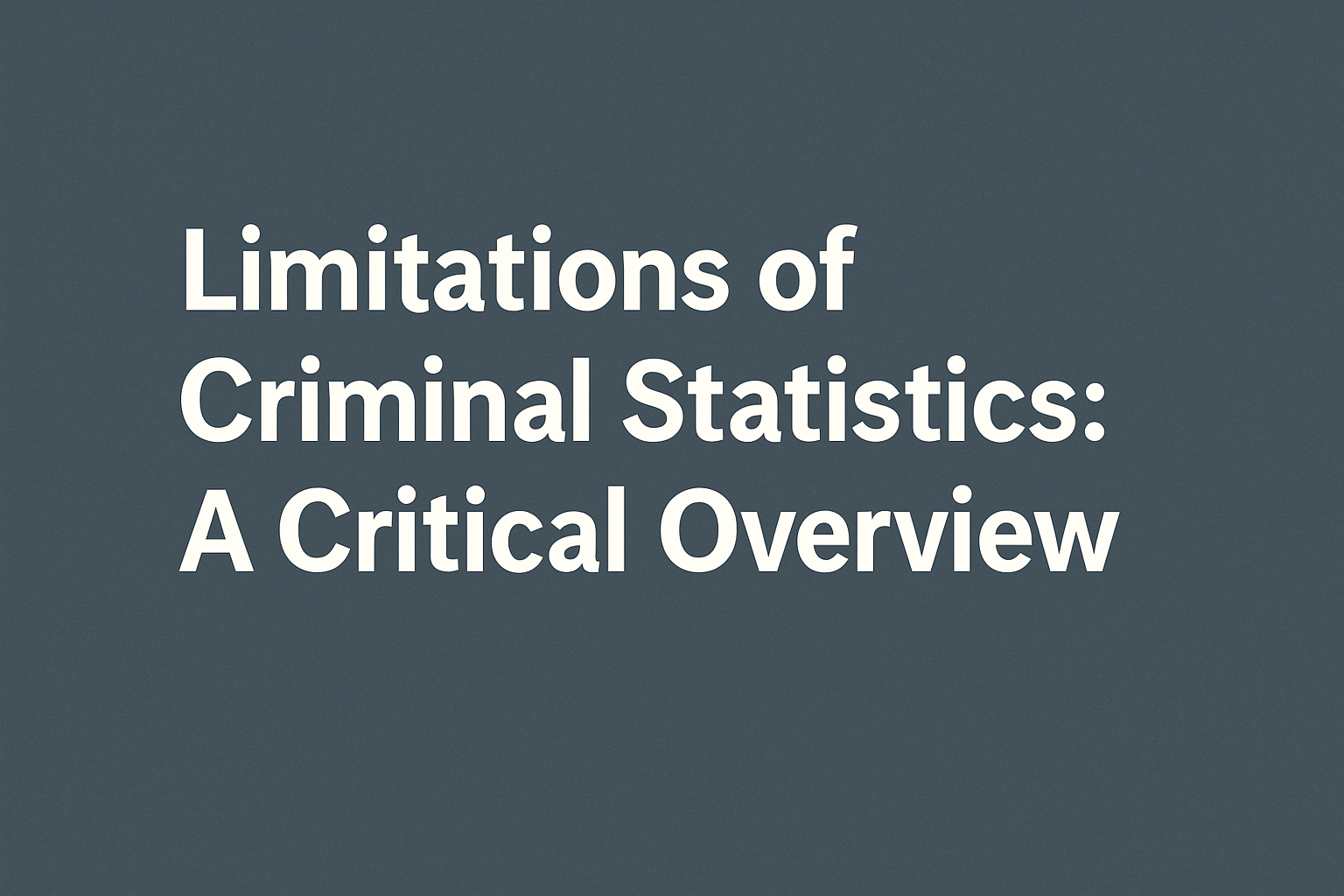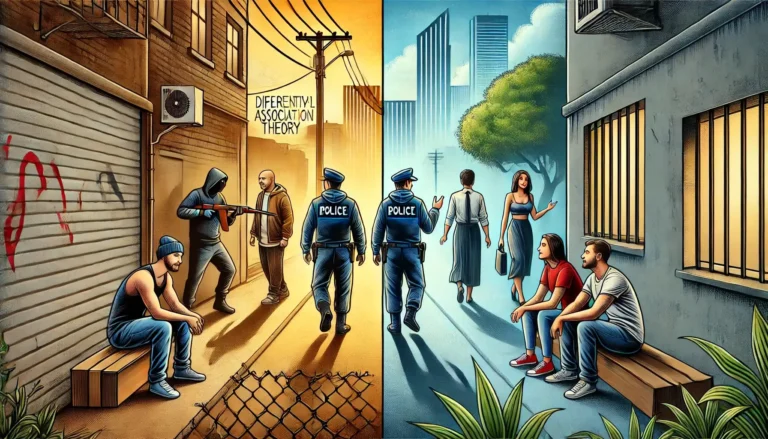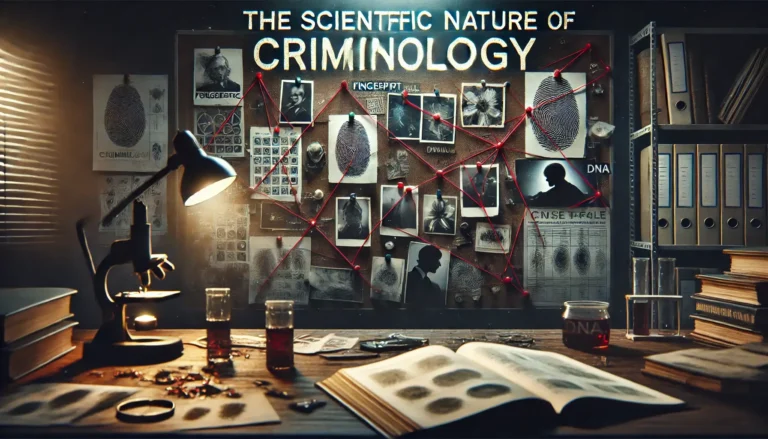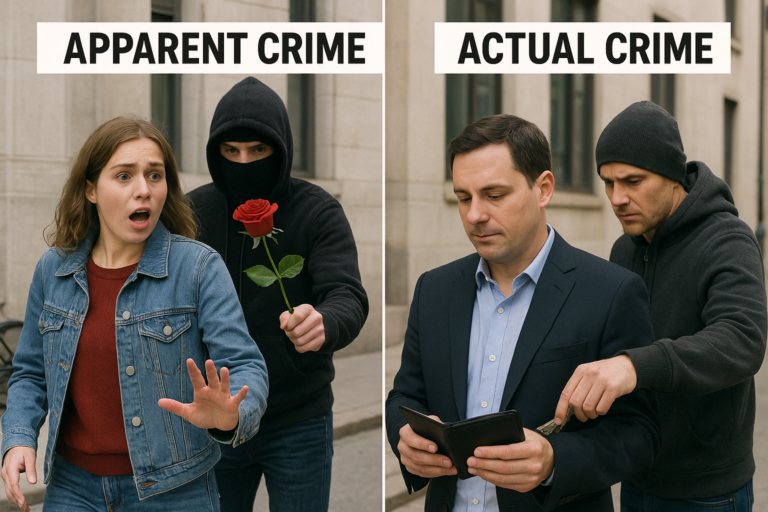Limitations of Criminal Statistics: A Critical Overview
Introduction
Criminal statistics serve as one of the most essential tools for understanding crime trends, evaluating law enforcement performance, and shaping public policy. However, these statistics are far from perfect. In fact, a critical examination reveals several limitations and distortions that significantly undermine their reliability and validity. Despite their widespread use in criminology, policymaking, and media reporting, criminal statistics often fail to present a full and accurate picture of crime. This article explores the inaccuracies, distortions, and broader limitations of criminal statistics and examines how they affect our understanding of crime and justice.
1. The Inaccuracy of Criminal Statistics
Criminal statistics are a cornerstone in the study of criminology and the administration of justice. However, their accuracy is often questioned due to several structural, social, and technical limitations. These inaccuracies have broad implications, affecting everything from public perception to criminal justice policies and resource allocation.
1.1 Underreporting of Crimes
Underreporting remains one of the most critical factors contributing to the inaccuracy of criminal statistics. Victims often do not report crimes due to fear, shame, distrust in law enforcement, or a belief that reporting will not lead to justice. In cases of domestic violence and sexual assault, underreporting rates are particularly high. According to global crime victimization surveys, only a fraction of sexual assaults are ever reported, leaving policymakers with data that grossly underrepresents the scope of the problem.
Moreover, marginalized communities may be even less likely to report crimes due to systemic mistrust of authorities or fear of immigration consequences. This lack of data leads to a distorted understanding of where and how crime occurs, influencing decisions about policing, prevention strategies, and victim support services.
1.2 Variability in Legal Definitions and Classifications
Another critical source of inaccuracy arises from the inconsistent definitions of crime across jurisdictions. What is legally categorized as a “violent offense” in one region might be considered a “property crime” in another. This makes national and international comparisons of crime rates highly unreliable. Even within the same country, differences in classification practices among police departments or local jurisdictions can result in data that is incompatible or misleading.
Such discrepancies affect both longitudinal studies and cross-sectional analyses, reducing the utility of criminal statistics for academic research and policy formulation. Without harmonized legal definitions, any comparison becomes inherently flawed.
1.3 Data Entry Errors and Administrative Failures
Errors in data entry and record-keeping further compromise the reliability of criminal statistics. Police officers and administrative staff often deal with high volumes of paperwork and tight deadlines, increasing the risk of typos, misclassifications, or data being input into the wrong system. For example, a simple mistake in labeling a robbery as a burglary can significantly skew statistical trends over time.
Additionally, crimes that are never formally processed, such as those resolved informally or not fully investigated, may never be entered into the system, leading to invisible gaps in the data.
1.4 Non-Standardized Reporting Procedures
There is often a lack of standardized procedures for how crimes are reported and recorded across different agencies. Some departments may require a formal report before entering a crime into their database, while others may include informal complaints. This inconsistency results in fragmented datasets that hinder efforts to compile comprehensive crime statistics at the national level.
Furthermore, different police forces might employ different technologies and software systems, which can lead to problems in data integration, duplication, or loss of information during transfers.
1.5 Exclusion of Unreported and Unsolved Crimes
Most criminal statistics focus solely on reported and recorded crimes. This excludes a massive portion of crimes that go undetected or unsolved. Crimes that occur in private spaces or those involving vulnerable individuals—such as elder abuse, child exploitation, or human trafficking—are often hidden and therefore unrepresented in official data.
Additionally, crimes that are reported but remain unsolved may not be fully analyzed or reflected in broader crime assessments, creating a statistical blind spot that weakens our understanding of criminal behavior.

2. Aspects of the Distortion of Criminal Statistics
While inaccuracies in criminal statistics are often unintentional, distortions can be deliberate or systemic. These distortions compromise the integrity of the data and can be used to serve political, institutional, or ideological purposes.
2.1 Political and Institutional Manipulation
Governments and law enforcement agencies may intentionally distort criminal statistics to maintain political narratives or protect institutional reputations. For example, lowering reported crime rates can create the illusion of successful policing, while emphasizing rising crime statistics may be used to justify increased funding, surveillance, or the introduction of tougher laws.
This manipulation may involve downgrading offenses (e.g., classifying an assault as a disturbance), delaying reports until after an election period, or omitting inconvenient data from public releases. Such practices erode public trust and foster cynicism toward the criminal justice system.
2.2 Media Amplification and Selective Presentation
The media plays a significant role in shaping public perceptions of crime. By focusing disproportionately on sensational crimes—such as homicides, school shootings, or terrorist acts—the media can amplify the perceived threat of violence, regardless of actual crime rates. This selective attention distorts public understanding and can drive political pressure for “tough on crime” policies, even when overall crime is declining.
In many cases, the media relies heavily on official police press releases without critically evaluating the completeness or accuracy of the data, further contributing to misinformation.
2.3 Statistical Misrepresentation and Data Framing
The way crime data is framed can also create distortions. For instance, presenting crime increases in percentage terms without raw numbers can exaggerate minor changes. A 50% increase in a rare crime may sound alarming, but in reality, it might represent a rise from 2 incidents to 3. Similarly, focusing on short-term spikes without contextualizing long-term trends can mislead readers and policy stakeholders.
In academic and political discourse, selective use of time periods, geographical areas, or demographic subsets can further skew the narrative to fit a specific agenda.
2.4 Law Enforcement Bias and Discriminatory Practices
Bias in policing—whether conscious or unconscious—can distort criminal statistics significantly. Racial profiling, targeted patrols in low-income neighborhoods, and differential treatment based on ethnicity or gender all influence the data collected. This means that areas with heightened police presence will naturally report more crimes, not necessarily because crime is higher there, but because more eyes are watching.
As a result, crime statistics can end up reinforcing stereotypes, legitimizing over-policing in marginalized communities, and perpetuating cycles of criminalization and inequality.
2.5 Pressure to Meet Performance Targets
In some jurisdictions, police departments are evaluated based on statistical performance—such as crime clearance rates or arrest numbers. This can create incentives to manipulate data to meet quotas. Officers may downgrade crimes, avoid reporting complex cases, or prioritize easy arrests to boost statistics.
Such distortions not only misrepresent the actual state of public safety but also divert resources away from more complex or less visible crimes, such as white-collar offenses or domestic abuse.
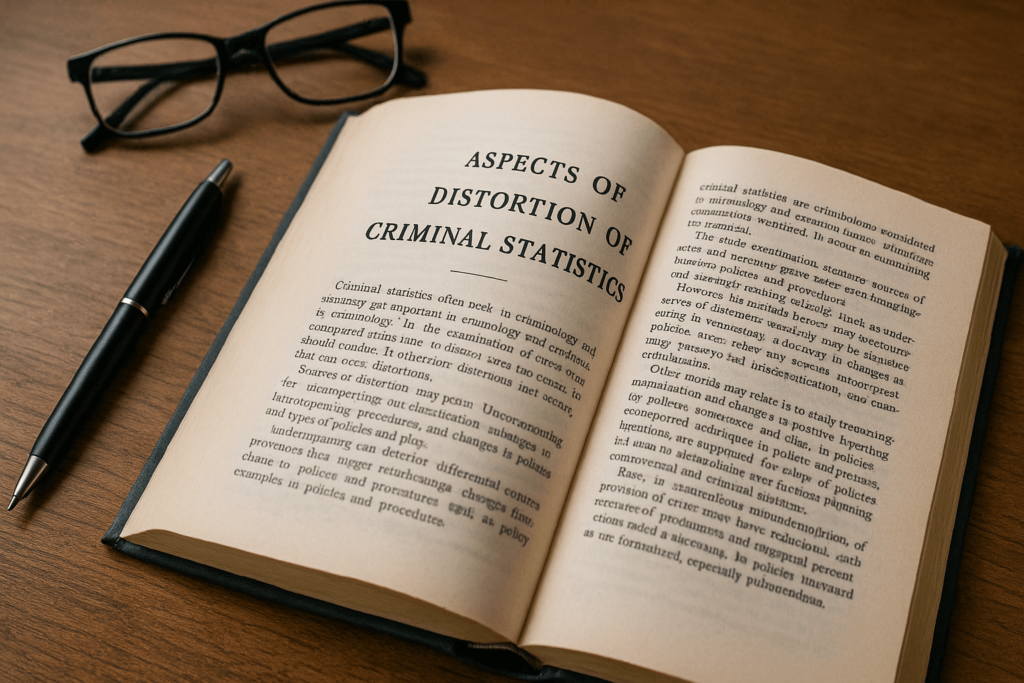
3. Broader Limitations of Criminal Statistics
Beyond inaccuracies and distortions, criminal statistics face broader structural limitations that must be acknowledged and addressed.
3.1 Lack of Contextual Information
Criminal statistics often fail to provide contextual information necessary for proper interpretation. Knowing the number of thefts in a given area, for instance, is less informative without understanding the socioeconomic conditions, local policies, or policing strategies that may influence those numbers.
Without context, statistics can easily be misinterpreted or misused, leading to ineffective or even harmful responses.
3.2 Invisibility of Certain Crimes
Some crimes are inherently difficult to detect and record, rendering them invisible in official statistics. White-collar crimes, human trafficking, organized crime, and cybercrime are examples of offenses that often go undetected or are poorly recorded. As a result, they are underrepresented in crime data, which shifts attention away from addressing these serious issues.
3.3 Time Lag in Data Availability
There is often a significant time lag between when a crime occurs and when it is reflected in official statistics. This delay can make it difficult for policymakers and law enforcement to respond to emerging crime trends in a timely manner.
Moreover, historical crime data may not be updated to reflect new information, such as reclassifications or corrections, further compromising its usefulness.
3.4 Overreliance on Quantitative Measures
Criminal statistics are primarily quantitative, focusing on numbers and rates. While useful, this approach often neglects the qualitative dimensions of crime, such as victim experiences, community impact, and social dynamics. Relying too heavily on numbers can lead to dehumanized policies that overlook the lived realities of affected individuals and communities.
4. Addressing the Challenges in Criminal Statistics
Recognizing the limitations and distortions in criminal statistics is the first step toward improvement. The following measures can help enhance the accuracy, transparency, and usefulness of crime data.
4.1 Incorporating Multiple Data Sources
To gain a more comprehensive understanding of crime, it is essential to combine data from multiple sources. Victimization surveys, academic studies, court records, and health data can complement police statistics and provide a fuller picture of crime and its impact.
4.2 Standardizing Crime Definitions
Efforts should be made to standardize the definitions and classifications of crimes across jurisdictions. This would facilitate better comparisons and improve the coherence of criminal statistics, especially at national and international levels.
4.3 Increasing Transparency and Accountability
Law enforcement agencies should be transparent about their data collection methods and any limitations or errors in their statistics. Independent audits and third-party evaluations can help ensure the integrity of crime data.
4.4 Promoting Ethical Use of Statistics
Governments, media, and researchers should commit to the ethical use of criminal statistics. This includes avoiding sensationalism, providing proper context, and acknowledging uncertainties or limitations in the data.
4.5 Investing in Data Literacy and Training
Police and administrative staff involved in data collection should receive training in accurate record-keeping and statistical analysis. Improving data literacy among law enforcement personnel can significantly reduce errors and improve data quality.dministrative staff involved in data collection should receive training in accurate record-keeping and statistical analysis. Improving data literacy among law enforcement personnel can significantly reduce errors and improve data quality.
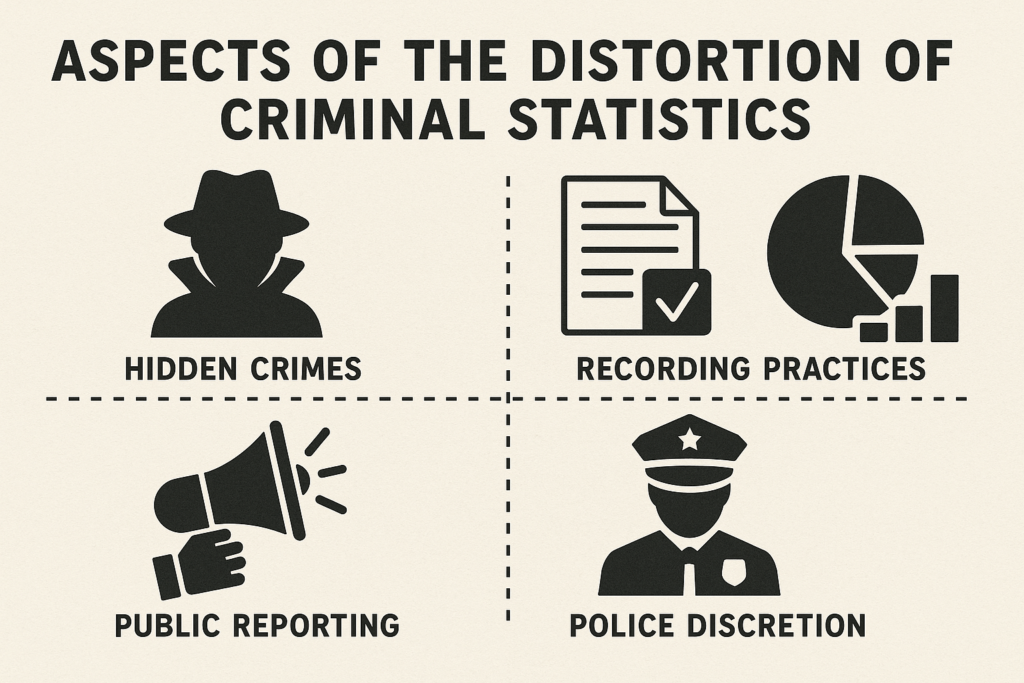
5. The Relationship Between Criminology and Criminal Statistics
Criminology, as a scientific discipline, relies heavily on data to understand crime patterns, criminal behavior, and societal responses to crime. Criminal statistics serve as one of the primary tools for criminologists to analyze trends, test theories, and propose evidence-based policies. Without accurate and comprehensive data, the study of crime would remain speculative and disconnected from reality.
Criminal statistics provide the empirical foundation for criminological theories. For instance, sociological theories that explore crime as a function of social inequality often use crime data stratified by race, income, or education. Similarly, psychological and biological theories may depend on statistics related to recidivism, mental health diagnoses, or substance abuse.
Furthermore, criminology uses statistical models to predict future crime trends, evaluate the effectiveness of interventions, and support legislative reforms. However, the utility of criminal statistics in criminology is directly proportional to their accuracy. When the data is flawed or manipulated, it compromises the entire scientific endeavor, potentially leading to ineffective or unjust policies.
Thus, the relationship between criminology and criminal statistics is both foundational and reciprocal: while criminology depends on reliable data, it also plays a critical role in critiquing, interpreting, and improving the way that data is collected and understood.
Conclusion
Criminal statistics are indispensable tools in the fight against crime and the pursuit of justice. However, they are far from flawless. Inaccuracies, distortions, and structural limitations often compromise their reliability and effectiveness. To truly understand and address crime, we must critically examine these statistics, acknowledge their shortcomings, and take proactive steps to improve them.
By fostering a more nuanced and transparent approach to crime data, we can create policies that are not only evidence-based but also fair and just. In the end, better statistics lead to better decisions—and ultimately, to a safer and more equitable society.
According to the most recent data from the United Nations Office on Drugs and Crime (UNODC), global homicide rates have shown a slight decline in recent years, yet disparities between regions remain stark. For instance, Latin America and the Caribbean continue to report the highest rates of intentional homicide, with over 15 victims per 100,000 population in some countries, compared to less than 1 per 100,000 in parts of Western Europe and East Asia. These figures not only highlight the uneven distribution of violent crime across the globe but also underscore the urgent need for localized, data-driven interventions. Incorporating such crime statistics into policy frameworks can enhance our ability to understand regional challenges and respond with targeted, context-sensitive solutions.

